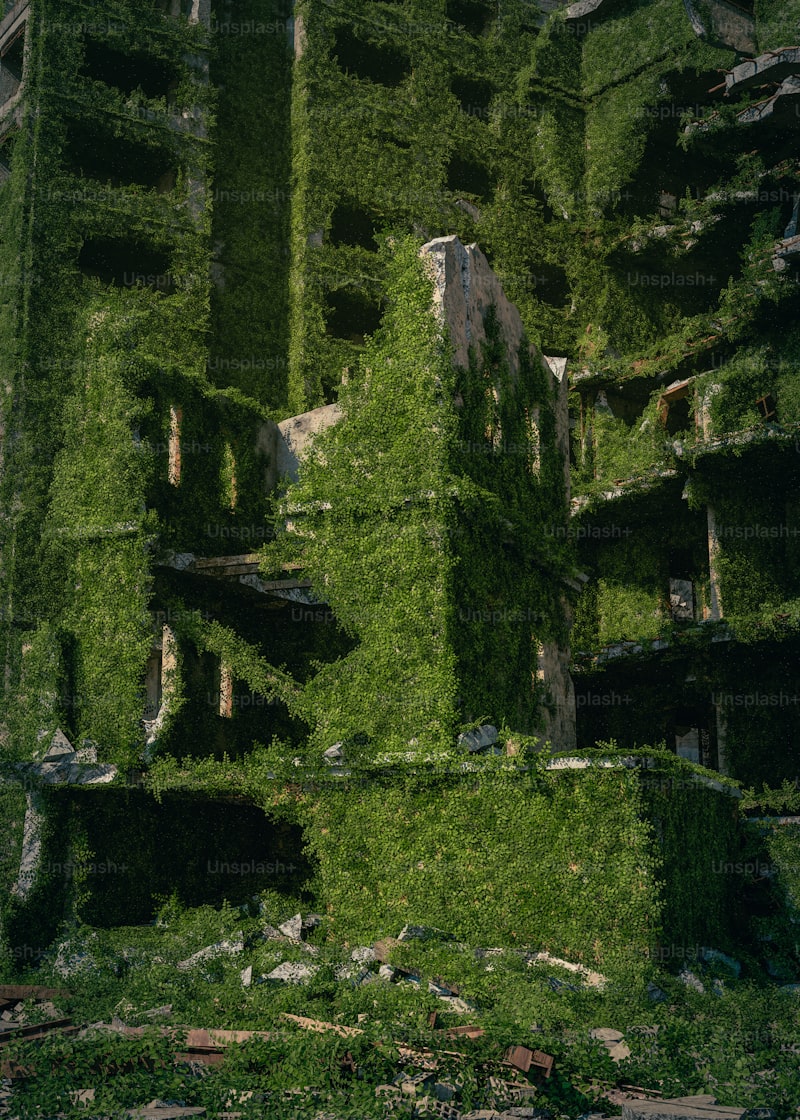Imagine walking down a once-forgotten alley downtown, now adorned with wildflowers bursting through cracks in the pavement. These resilient plants, like pioneers of a new frontier, soften the harsh edges of city life with their delicate blooms. They thrive despite the odds, their roots delving deep into the urban soil, reclaiming it one inch at a time.
Birdsong echoes where car horns once blared incessantly. Trees planted long ago now stand tall, their branches providing shade to weary pedestrians. Squirrels dart among the branches, creating a lively spectacle against the backdrop of skyscrapers. It’s a testament to nature’s resilience and its unwavering determination to flourish in unexpected places.
In parks reclaimed from abandoned industrial sites, families gather on weekends, picnicking where warehouses once stood. Children play on swings hung from repurposed steel beams, laughing under the watchful eyes of old factory walls now covered in ivy. The air, once thick with pollutants, now carries the scent of freshly cut grass and blooming flowers.
But this transformation isn’t just about aesthetics. Nature’s return to urban spaces brings tangible benefits. Green roofs insulate buildings, reducing energy costs. Urban gardens provide fresh produce and community gathering spaces. Wetlands and green corridors mitigate flooding and support biodiversity.
As we witness nature reclaiming these urban spaces, it reminds us of the delicate balance between development and sustainability. It challenges us to rethink our cities as living ecosystems where humans and nature coexist harmoniously. Each blade of grass, each tree planted, is a step towards a greener, more resilient future for our urban landscapes.
Concrete Jungle Reborn: How Nature Is Taking Back Urban Landscapes
Gone are the days when cities were synonymous with concrete and steel alone. Today, parks, green roofs, and vertical gardens are becoming integral parts of urban planning. These green spaces not only beautify but also serve crucial ecological functions, from absorbing carbon dioxide to mitigating urban heat islands.
Imagine strolling down a city block lined with trees, their leaves rustling in the breeze, providing shade and a sense of tranquility amid the urban hustle. These pockets of greenery are not just aesthetically pleasing but contribute to improving air quality and enhancing biodiversity.
The resurgence of nature in urban areas isn’t merely a trend; it’s a response to the pressing need for sustainability and resilience in the face of climate change. Cities are embracing green infrastructure as a means to adapt and thrive in a rapidly changing world.
Moreover, this green revolution is not without its challenges. Urban planners and environmentalists must navigate issues such as limited space and competing interests to ensure that nature’s comeback is sustainable and inclusive.
From Asphalt to Oasis: Urban Spaces Transformed by Nature’s Resurgence
Imagine strolling down a bustling city street, surrounded by skyscrapers and concrete structures. Now, envision this same scene transformed into a lush green oasis, with vibrant plants and serene water features. This vision is becoming a reality in many urban areas around the world, where nature is making a comeback in unexpected places.
Cities, once synonymous with gray infrastructure and limited green spaces, are embracing the concept of urban greening. This trend involves integrating natural elements into urban environments to enhance biodiversity, improve air quality, and create more livable spaces for residents. From rooftop gardens to vertical forests, architects and urban planners are reimagining the cityscape as a harmonious blend of human habitation and natural beauty.


One striking example of this transformation is the High Line in New York City. What was once an abandoned elevated railway has been revitalized into a stunning linear park, featuring native plantings, walking paths, and panoramic views of the city skyline. The High Line not only provides a green retreat for locals and tourists alike but also serves as a model for sustainable urban development.
In Singapore, the Gardens by the Bay stand as a testament to the city-state’s commitment to integrating nature into its urban fabric. These futuristic gardens boast towering Supertrees clad in ferns and orchids, creating a surreal landscape that merges technology with biodiversity. Visitors can wander through climate-controlled conservatories filled with exotic plants, or marvel at the nightly light shows that illuminate these green giants.

Beyond aesthetic appeal, urban greening offers tangible benefits to city dwellers. Green spaces act as natural air purifiers, filtering out pollutants and reducing urban heat island effects. They also provide habitats for wildlife and opportunities for outdoor recreation, promoting physical and mental well-being among residents.
As cities continue to grow and evolve, the importance of balancing urban development with environmental sustainability becomes increasingly clear. By embracing nature’s resurgence and integrating green spaces into urban planning, cities can enhance their resilience to climate change and improve quality of life for generations to come.
Greening the Gray: The Quiet Revolution of Nature in Urban Environments
Cities are embracing green infrastructure like never before. Rooftop gardens, vertical forests, and pocket parks are breathing life into the urban fabric. These green oases not only provide havens for city dwellers but also mitigate the urban heat island effect, improve air quality, and support biodiversity.
Imagine strolling down a busy city street lined with trees that provide shade in the summer and a burst of color in the fall. These green sentinels not only cool the air but also filter pollutants, making the environment healthier for everyone. They create habitats for birds and insects, fostering a connection between urbanites and the natural world.
Moreover, urban farming initiatives are turning vacant lots into productive gardens, supplying fresh produce to local communities. These initiatives not only promote food security but also educate urbanites about sustainable living practices. It’s a reminder that nature’s bounty can thrive even in the most unexpected places.
The benefits extend beyond environmental impact. Green spaces in cities have been shown to reduce stress, boost mental health, and enhance overall quality of life. They serve as gathering places for communities, where people can unwind, exercise, or simply enjoy the serenity of greenery amidst the urban hustle.
Beyond Concrete: Exploring Nature’s Return to Urban Centers
Imagine strolling down a city street lined not just with skyscrapers, but with lush greenery intertwining among the architecture like a verdant tapestry. Parks and green spaces are no longer just isolated oases but integral components of urban planning, offering havens where residents can escape the clamor of city life and reconnect with nature. These green lungs not only provide recreational spaces but also improve air quality, mitigate urban heat islands, and promote biodiversity.
Rooftop gardens and vertical forests have become architectural marvels, transforming barren rooftops and facades into thriving ecosystems. These green innovations not only enhance the aesthetic appeal of buildings but also contribute to energy efficiency by providing natural insulation and reducing the need for artificial cooling.
Furthermore, urban farming initiatives are bringing agriculture back to the city. From community gardens to rooftop apiaries, urban dwellers are rediscovering the joy and sustainability of growing their own food within city limits. This not only reduces the carbon footprint associated with food transport but also fosters a sense of community and resilience.
Nature’s return to urban centers is not just about greening concrete jungles; it’s about reimagining urban spaces as places where people and nature coexist harmoniously. It’s about creating cities that are not just places to live and work but places to thrive — where the sights and sounds of nature complement the rhythm of urban life.
Urban Renewal: The Role of Plants and Wildlife in Reclaiming Cities
In bustling cities worldwide, the greening of urban areas has become a pivotal strategy. From rooftop gardens to vertical green walls, these initiatives not only beautify but also serve essential functions. Plants act as natural air purifiers, absorbing carbon dioxide and releasing oxygen, thereby improving air quality. They also mitigate the urban heat island effect, where cities become significantly warmer than their rural surroundings due to human activities and structures absorbing and retaining heat.
Moreover, green spaces enhance biodiversity by providing habitats for various wildlife species. Birds, insects, and small mammals find refuge in urban parks and gardens, contributing to the ecological balance. This biodiversity isn’t just pleasant to observe; it’s crucial for maintaining healthy ecosystems within urban environments.
Beyond environmental benefits, integrating plants and wildlife into cities enhances the well-being of residents. Green spaces offer places for relaxation, exercise, and social interaction, promoting mental and physical health. They reduce stress levels, increase happiness, and even contribute to higher property values in surrounding areas.
The trend towards incorporating nature into urban planning reflects a broader understanding of sustainable development. Cities are adapting to climate change challenges by becoming more resilient and ecologically sound. Governments and communities are increasingly investing in green infrastructure, recognizing its role in creating livable, sustainable urban environments.
Frequently Asked Questions
How do urban planners incorporate nature reclamation strategies
Learn how urban planners integrate nature reclamation strategies into city planning to enhance sustainability and biodiversity. Discover key methods and considerations for incorporating green spaces, eco-friendly infrastructure, and biodiversity corridors into urban environments.
What are examples of urban spaces reclaimed by nature
Discover examples of urban spaces reclaimed by nature, showcasing areas where human-built environments have been transformed by natural processes. Explore how abandoned lots, rooftops, and disused infrastructure are revitalized into parks, gardens, and wildlife habitats, demonstrating sustainable urban renewal.
How does nature reclaim abandoned urban areas
Learn how nature naturally revitalizes abandoned urban areas over time, transforming neglected spaces into biodiverse habitats through natural succession processes.
Why is nature reclaiming urban spaces important
Discover why the reclamation of urban spaces by nature is crucial for environmental sustainability and human well-being. Explore how this process restores biodiversity, improves air quality, mitigates urban heat islands, and enhances urban aesthetics, creating healthier and more resilient cities.
What are the environmental benefits of nature reclaiming urban spaces
Discover how nature reclaiming urban spaces can benefit the environment by restoring biodiversity, improving air quality, reducing urban heat islands, and promoting sustainable ecosystems.


